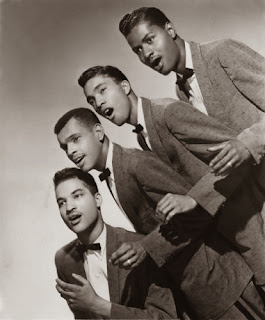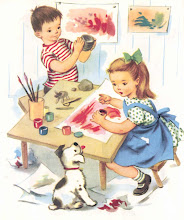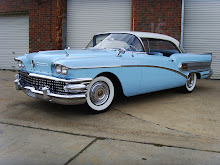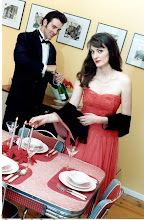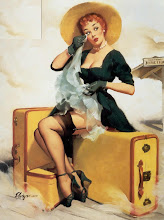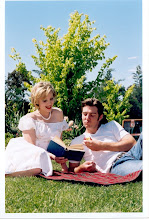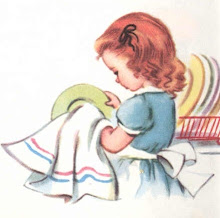My inspiration for a new year full of possibilities !
Tuesday, December 31, 2013
Sunday, December 22, 2013
Delectable Christmas Wreath
Well, it has been some time since I posted a baking article, so here is one just in the nick of time for all those Christmas festivities. Remember the age old 'chocolate log cake' from childhood BBQ's and pot luck dinners? Well, this beautiful festive dessert has taken the traditional chocolate log and turned it into a Christmas wreath.
Simply grab two packets of chocolate ripple cookies at the supermarket, and a generous tub of cream. Don't forget your chosen lolly decorations. (I used Cherry Ripe, Spearmint leaves and jaffas)
Whip your cream with an electric or hand held mixer and proceed to create chocolate ripple cookie 'sandwiches' with the cream in the shape of a circle on a large plate.
Cover the entire wreath with cream and decorate in any way that seems creative to you.
Too easy ! (And too yummy!!)
Friday, December 20, 2013
‘Oh Brad, I’d love to show you my flower garden’
What’s not to like about gardens and their history.
The plants they contain provide riches almost
without limit, spanning an astonishing physical, social, and cultural spectrum.
From utility to ornament, their almost inexhaustible patrimony has clothed,
fed, warmed, protected, and inspired humans since the dawn of time.
Gardens have profound significance to
humankind. They have universal value as repositories of cultivated plants,
maintained using the skills of horticulture, and ordered through diverse
processes bound by tradition and innovation. They are intrinsically linked to
organic nature and, through this bond, with the shared biological cycles of
life cycles of humankind.
Such associations have imbued plants and
gardens with rich symbolism, venerated and celebrated in myth and
tradition. Gardens can also ornament,
gratify, and inspire. In short, gardens and their plants are vital to human
survival and spiritual wellbeing
Much more than art and architecture, gardening
and garden-making have an egalitarian basis permitting these pursuits to be
practised by a potential population many times greater than those who create
other art forms. So while the spectacular gardens of Versailles, Stourhead, and
Central Park are iconic destinations for garden lovers, the humble backyard
vegetable patch, funky patio, arty pop-up installation, and tattered nursery
catalogue are all of equal interest to garden historians.
And I’m fortunate to be in the thick of it,
co-editing Australian Garden History
(quarterly journal of the Australian Garden History Society), as author
of books such as Gardenesque, Botanical Riches, The Garden of Ideas and Cultivating Modernism, and a
passionate collector of gardening ephemera (see Brad and Janet above).
In my writing, I love the interaction between
image and text, place and context, author and reader. These are all intimate
and vital links that help place gardens at the forefront of Australian cultural
and social history. Stay tuned.
Richard Aitken
(guest blogger)
Tuesday, December 17, 2013
Fun on Saturday......
Support your locally made music and musicians people! This is one sure fire way to keep commercialised overproduced and heavily manipulated mainstream music on its toes guys....get along to REAL music events in your town and enjoy the creativity.
Here is one such event this Saturday that you are sure to love.......
Saturday, December 14, 2013
Top 10 Love Songs
Everyone has a favourite sentimental song that reminds them of a good time, a new love, even an unrequited love, and as we focus on a pre 1965 theme here, it was interesting to a music lover like myself to observe my readers diverse tastes. So without further ado, lets jump into the Alice Jean's top ten love songs list.......
Number 10
"L-O-V-E" is a jazz song written by Bert Kaempfert and Milt Gabler for American singer-pianist Nat King Cole's 1965 album L-O-V-E (the last album released before Cole's death on February 15, 1965). The trumpet solo is by Bobby Bryant. The song had already been an instrumental track on Kaempfert's Blue Midnight album in 1964.
Number 9
Two Cole family members have put this ever popular song onto the Alice Jean's list at number 9. Nat King and Natalie Cole with Unforgettable. I remember this one on the charts in my high school years at a time of unrequited love for me - today I fondly remember the song, but cant for the life recall who I was so over the moon about. What is your memory of this classic?
Unforgettable is a popular song written by Irving Gordon. The song's original working title was Uncomparable. The music publishing company asked Irving to change it to Unforgettable. The song was published in 1951.
The most popular version of the song was recorded by Nat King Cole in 1951, with an arrangement written by Nelson Riddle. A non-orchestrated version of the song recorded in 1952 is featured as a bonus track on the CD reissue of 1955's completely instrumental (save the bonus material) Penthouse Serenade. Cole recorded the tune anew in 1961, in a stereo version of the Riddle arrangement, for the album The Nat King Cole Story. His version of the song was included in its entirety in the 2009 film Watchmen during the Comedian's death scene.
In 1991, after Elvis Presley's legendary musical director Joe Guercio had the idea, Cole's 1961 recording of the song was edited and remixed to create a duet with his daughter, Natalie, which won three awards at the Grammy Awards of 1992: Song of the Year, Record of the Year and Best Traditional Pop Vocal Performance.[1]
Number 8
"Can't Help Falling in Love" is a pop song originally recorded by American singer Elvis Presley and published by Gladys Music, Elvis Presley's publishing company. It was written by Hugo Peretti, Luigi Creatore, and George David Weiss. The melody is based on "Plaisir d'Amour"[2] (1784), a popular romance by Jean Paul Egide Martini (1741–1816). It was featured in Elvis Presley's 1961 film, Blue Hawaii.
Number 7
Earth Angel (Will You Be Mine)" is an American doo-wop song, originally released by The Penguins in 1954 on the Dootone label (Dootone 348), as the B-side to "Hey Señorita."[1] The song was originally recorded as a demo at Ted Brinson's garage studio in South Los Angeles in October 1954, with producer Dootsie Williams.[2] "Earth Angel" quickly outstripped its A-side in popularity and reached No. 1 on the Billboard R&B chart for three weeks in early 1955 and No. 8 on the pop chart.[3] Covered many times since, the love song would prove to be the only top 40 hit from the group.
The song became a major hit for The Crew-Cuts in 1955, reaching the Billboard charts on January 29, 1955. It peaked at No. 3 on the Disk Jockey chart, No. 8 on the Best Seller, and No. 8 on the Juke Box chart. The flip side, "Ko Ko Mo (I Love You So)," also charted.
The version of "Earth Angel" recorded by The Penguins ranked No. 152 on Rolling Stone's list of the 500 Greatest Songs of All Time. In 2004, it was one of 50 recordings chosen by the Library of Congress to be added to the National Recording Registry.
Number 6
"Smoke Gets in Your Eyes" is a show tune written by American composer Jerome Kern and lyricist Otto Harbach for their 1933 musical Roberta. It was sung in the original show by Tamara Drasin and originally recorded by Gertrude Niesen on October 13, 1933, on the Victor label 24454. It was performed by Irene Dunne for the 1935 film adaptation, co-starring Fred Astaire, Ginger Rogers and Randolph Scott.
Possibly the most famous version was recorded in 1958 by The Platters, which became a number one hit on the U.S. Billboard Hot 100 — it reached number three on the R&B charts in 1959[1] — and on the UK charts, where it spent five weeks at the top in February and March of that same year.[2]
It has been covered by numerous artists, beginning with Paul Whiteman and His Orchestra with Bob Lawrence on vocal, which went to the top of the charts in 1934, and including Nat "King" Cole, who first covered it in 1946. It also featured in Lovely to Look At, a 1952 remake of Roberta, where it was sung by Kathryn Grayson. In 1956, Vic Damone covered this song with a very different rendition, which became one of his most famous songs.
For bandleader Ray Conniff, it was one of his signature songs during his career. A 1972 remake by British band Blue Haze, formed by Johnny Arthey and Phil Swern,[3] also became popular. Saxophone player Boots Randolph did an instrumental version of the song on the B-side of his LP Yakety Sax. Bryan Ferry recorded a quavering version of the song in 1974 on the album Another Time, Another Place, which reached number 17 on the UK charts in September 1974. Jerry Garcia, who was named after Jerome Kern, released a music video in the early 1990s covering the song, with actress Ashley Judd sitting in the background listening. In the early 1990s, the song was performed by Eartha Kitt as part of her work with a small jazz combo in Germany; these recordings are preserved under the name Thinking Jazz.
Number 5
The song was recorded in the Saint Bernadette Catholic School basement in New Haven, Connecticut, in February, 1956. Marty Kugell produced the song. The saxophone solo was played by Vinny Mazzetta, of New Haven.The rhythm section was Doug Murray, bass, Bobby Mapp, drums and Curlee Glover, piano. It was originally released as a B-side (to "The Jones Girl", a play on the Mills Brothers' 1954 hit, "The Jones Boy") on Kugell's Standard Records label. Although the single was only a moderate hit (after it was reissued on the Ember label), peaking at #24 on the national pop charts and #3 on the R&B "race" charts (Billboard's chart designation for R&B during that time), its reputation came to surpass its original chart placement. For three decades, the single almost always topped the influential Top 500 Songs countdown on oldies radio station WCBS-FM. The track sold over 10 million copies in 1987 and 1988 as part of the Dirty Dancing soundtrack. It is ranked #90 on the Rolling Stone magazine's list of "the 500 Greatest Songs of All Time". (The song was included on the highly influential 1959 LP Oldies But Goodies on Original Sound.)
"In the Still of the Night" is the only song to have charted on the Billboard Hot 100 three separate times, by the same artist with the same version each time. After initially reaching #24 in 1956, it was released again in 1960 and reached #81. Then more than a year later in 1961 it reached #99.
"In the Still of the Night" is one of two songs that may lay claim to being the origin of the term doo-wop. The plaintive doo wop, doo wah refrain in the bridge has often been suggested as the origin of the term to describe that musical genre. (The other contender for the honor is "When You Dance" by The Turbans, in which the chant "doo-wop" can be heard.)
Number Four
"These Arms of Mine" is a song written by soul musician Otis Redding. Redding, at that time a member of Teacake's Band, consisting of lead guitarist Johnny Jenkins, bassist Pat Teacake and himself, served as the driver for Jenkins, as he did not possess a driver's license. Atlantic Records representative Joe Galkin showed interest in Jenkins and proposed to send him to a studio. On the way to a gig, Redding had the opportunity to perform the songs "Hey Hey Baby" and "These Arms of Mine", as the set of Jenkins and the house band Booker T. & the M.G.'s ended earlier than proposed.
The performance of the latter song was highly praised; Jim Stewart was so impressed that he gave him a contract to Stax, which he signed soon after. "These Arms of Mine" became his first single on Stax, with "Hey Hey Baby" on the B-side. After a series of unsuccessful songs, "These Arms of Mine" became Redding's first successful single and sold around 800,000 copies. The song was later included in Redding's debut album, Pain in My Heart.
Number Three
Ahh, Hollywood. Where would modern movies be without classic mid century music to invigorate their soundtracks ! Think 'You've lost that lovin feeling' - Top Gun, 'It had to be you' - When Harry Met Sally and of course 'Unchained Melody' - Ghost. I learnt by reading Wikipedia, that this song was actually written for a little known movie - Unchained - and that is where it got the title. Thankgoodness for Wikipedia, I had always been baffled by the name of this song. And here it is at number three in the Alice Jeans best love song list for us to receive goosebumps once again at the powerful vocal range of the Righteous Brothers.
"Unchained Melody" is a 1955 song with music by Alex North and lyrics by Hy Zaret. North used the music as a theme for the little-known prison film Unchained, hence the name. Todd Duncan sang the vocals for the film soundtrack.[1] It has since become one of the most recorded songs of the 20th century, by some estimates having spawned over 500 versions in hundreds of different languages.[2]
Les Baxter (Capitol Records catalog number 3055) released an instrumental version which reached #1. Then came song recordings by Al Hibbler (Decca Records #29441),[3] reaching #3 on the Billboard charts; Jimmy Young which hit #1 in the United Kingdom; and Roy Hamilton (Epic Records no. 9102), reaching #1 on the R&B Best Sellers list and #6 on the pop chart.[4] Hundreds of other recordings followed. However, it was the July 1965 version by The Righteous Brothers that became a jukebox standard for the late 20th century, achieving a second round of great popularity when it was featured in the 1990 blockbuster film Ghost.
Number 2
Number 1
"At Last" is a 1941 song written by Mack Gordon and Harry Warren for the musical film Orchestra Wives, starring George Montgomery and Ann Rutherford. It was performed in the film and on record by Glenn Miller and his orchestra, with vocals by Ray Eberle and Pat Friday. Unreleased recordings of the song, however, had been made in 1941 by Glenn Miller for possible inclusion in the film Sun Valley Serenade. An orchestral version of the song without lyrics first appeared in that movie in 1941. A new version was recorded by Glenn Miller and His Orchestra in Chicago on May 20, 1942, and released by RCA Victor Records as a 78 single, catalogue number 27934-B, backed with the A side "(I've Got a Gal In) Kalamazoo". The song reached number 9 on the Billboard pop charts in 1942, staying on the charts for 9 weeks, and later became a standard. In 1960, it was covered by blues singer Etta James in an arrangement by Riley Hampton that improvised on Warren's melody. James' version was the title track in the same-named album At Last! and was inducted into the Grammy Hall of Fame in 1999.[1]
So a very big thankyou one and all for indulging a passionate sentimentalist like me. I have loved the insights into the collective romantic mind of my followers, and I do hope you enjoyed this happy little sojourn through some soppy music history. Below are the list of songs that didn't make it into the top 10 - you will find some very worthy numbers there that were only voted for once, but are thoroughly worth checking out just the same. Much love to all this Christmas Season! XOXO
Dearest (Buddy Holly)
A thousand stars (Kathy Young and the Innocents)
True love ways (Buddy Holly)
You go to my head (Marline Detirch)
These foolish things (Ella Fitzgerald)
My funny Valentine (Ella Fitzgerald)
Where the boys are (Connie Francis)
Just in time (Tony Bennet or Dean Martin)
Only You (The Platters)
Feelin Good (Nina Simone)
All I want (The Miracles)
Sincerely (The Maguire sisters)
If you go away (Dusty Springfield)
Someone to watch over me (Ella Fitzgerald)
I want you I need you I love you (Elvis)
Only have eyes for you (The Flamingoes)
Send me someone to love (The Moonglows)
You don't know me (Elvis)
Fly me to the moon (Frank Sinatra)
My baby just cares for me (Nina Simone)
Love me tender (Elvis)
Sea of love (Phil Phillips)
Will you still love me tomorrow (The Shirelles)
Blue Moon (the Marcels)
Sha-boom (The Chords)
I cant help myself (The Four Tops)
Chances Are (Johnny Mathis)
You belong to me (The Duprees)
My Man (Billie Holiday)
Your true love (Carl Perkins)
Adorable (The Drifters)
And a massive big thankyou to Rock n Roll for his ultimate male take on the 'biggest' love song pre 1965.......listen if you dare people (its brilliant!) ...he he !
My big 10 inch (Bull Moose Jackson)
Subscribe to:
Posts (Atom)









